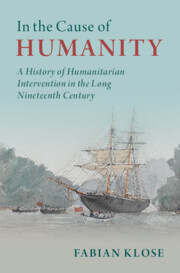Book contents
- In the Cause of Humanity
- Human Rights in History
- In the Cause of Humanity
- Copyright page
- Contents
- Acknowledgements
- Abbreviations
- Introduction
- Part I Interventionism and Humanitarianism under the Sign of Internationalism
- Part II The Struggle against the Atlantic Slave Trade and the Emergence of a Humanitarian Understanding of Intervention
- 4 Dehumanisation and Humanitarian Mobilisation
- 5 From National Ban to International Implementation
- 6 Possibilities and Limits of International Cooperation
- Part III Humanitarian Intervention and Its Solidification as an Imperial and Colonial Practice
- Notes
- Bibliography
- Index
6 - Possibilities and Limits of International Cooperation
from Part II - The Struggle against the Atlantic Slave Trade and the Emergence of a Humanitarian Understanding of Intervention
Published online by Cambridge University Press: 25 November 2021
- In the Cause of Humanity
- Human Rights in History
- In the Cause of Humanity
- Copyright page
- Contents
- Acknowledgements
- Abbreviations
- Introduction
- Part I Interventionism and Humanitarianism under the Sign of Internationalism
- Part II The Struggle against the Atlantic Slave Trade and the Emergence of a Humanitarian Understanding of Intervention
- 4 Dehumanisation and Humanitarian Mobilisation
- 5 From National Ban to International Implementation
- 6 Possibilities and Limits of International Cooperation
- Part III Humanitarian Intervention and Its Solidification as an Imperial and Colonial Practice
- Notes
- Bibliography
- Index
Summary
This form of international cooperation offered completely new possibilities for the suppression of a system of human trafficking that operated across oceans and continents, but at the same time it conflicted with the interests of particular states and their own mutual rivalries and on several occasions threatened to founder on the limitations imposed by national sovereign rights. Alongside the viability of the agreed measure, then, Chapter 6 looks at the diplomatic wrangling by which the British government tried to secure treaty obligations from as many states as possible and to overcome massive political resistance, notably from Spain, Portugal, Brazil, France and the United States. Yet this decades-long process of negotiation produced a mounting international consensus, particularly from the mid-1840s onwards, condemning slavery as a ‘crime against humanity’. One telling sign of this new moral climate was the emergence of one of the first international treaty regimes, which extended from Europe across North and South America and the Arab World to East and West Africa. Its foundational idea was to enforce an agreed humanitarian norms by military means if necessary. The fight against the slave trade, it is argued, gave rise to a new conception of intervention, and abolitionism became established as a key international guiding norm for ‘civilisational’ action in the long nineteenth century.
Keywords
- Type
- Chapter
- Information
- In the Cause of HumanityA History of Humanitarian Intervention in the Long Nineteenth Century, pp. 102 - 132Publisher: Cambridge University PressPrint publication year: 2021

